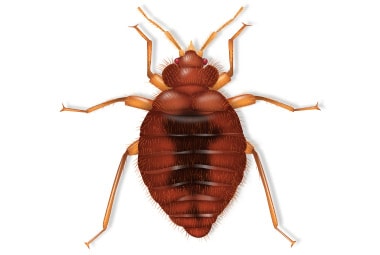
Bat Bugs are a tiny bloodsucking insect. They are a parasite that lives primarily on bats. They will, however feed on other animals and humans in the absence of their preferred host. These tiny blood suckers are often mistaken for bed bugs.
| Pest Identification | |
|---|---|
| Recognition | They are from the family of the Cimicidae. Like all members of this family they are small, oval-shaped and extremely flat when underfed. They are reddish-brown in color and are about 3/8 of inch long. After feeding they appear plump and darker colored due to the blood meal. To the naked eye they appear to be a bed bug. It is only under microscopic examination that a trained eye can see the minute difference between them and bed bugs. The only difference between these two blood suckers is the length of the fringe hairs on the ‘pronotum’ (upper covering of the thorax) of the bed bug is shorter than that of the bat bug. |
| Biology | Adult bat bugs can survive for a year of more without a blood meal in a perfect environment, but a blood feeding is required for a female to produce eggs. These eggs are placed in area where the females are resting to digest their food. Dark cracks and crevices are usually where the eggs are found. Nymphs are hatched from the eggs in seven to fourteen days after being laid. Nymphs are practically colorless until they have their first blood meal. The first blood meal creates a noticeable dark spot in their digestive track. As they mature their exoskeleton becomes darker. Growing from egg to adult takes approximately six weeks, but this all hinges on the food availability and type of environment that the bat bug is exposed to. In optimum warm conditions, the development is complete in about two weeks, but if the conditions are not favorable than full growth and development can take up to fifteen weeks. Bat bugs will breed throughout the year, paying no attention to the season, as long as the environment that that are in stays favorable for them to do so. |
| Habits | Bat bugs, like their name suggests, are typically with bats. They move from place to place by getting a ride with a bats or other secondary hosts. After feeding on their host, they crawl away into a dark place of refuge to digest their meal. After digesting their meal, they emerge again when hungry. Typically, bat bugs feed while their host I sleeping. The skin of the host is pierced with the bugs’ extendable mouthparts, it injects saliva and then feeds on the blood that it finds. Younger bugs eat quickly and are filled with their blood meal much faster than that of an adult. Adults sometimes can take up to ten or fifteen minutes to get their fill. While bats are certainly their preferred meal, these parasites can be found on rodents, and birds. They search out food if necessary and can feed from a sleeping human. Once their original host has been moved, or eliminated they will search out a suitable replacement. If brought to an area by bats, and then the bats are eliminated they will hide in the cracks and crevices until either a suitable host passes by, or they get hungry enough to go in search of one. Bat bugs can be found in places like: -Chimney areas -Roof-wall joint -Under loose fascia boards -In the attic near unscreened or broken attic vents -Cracks or openings in the ceiling -Wall void next to a window -Cracks and crevices in mattresses -Bedding -Bed frame -Voids in woodwork, trim and furniture -Inside drapery -Behind peeling wallpaper, picture frames and wall hangings |
| Prevention | Preventing bat bugs is really two fold. It includes eliminating them and is also about preventing their hosts from entering into your building. Keeping bats, rodents and birds out of your home will significantly reduce your likelihood of a bat bug infestation. Weatherproofing and maintaining your home regularly prevents bats from roosting in it. Some ways to deter bats from entering your home or building include: -Caulk cracks and crevices in the exterior of the structure. -Repair or replace damage to screens on windows, doors, attic vents and chimneys. -Keep siding and fascia boards tightly attached to the exterior walls. By eliminating these common entry points you are less likely to have a bat, or alternate host like rodents or birds enter your home and bring in bat bugs. |
| Professional | Controlling bat bugs is about controlling all aspects of their presence. Rodents, birds and bat bug elimination is best done through an integrated pest management program with a professional pest management company. Here at Rottler Pest and Lawn Solutions, we will eliminate these blood sucking pest from your home, building or business with our multifaceted approach. Our multifaceted approach includes: -Location of problem areas -Identification of pest -Sanitation of area effected -Treatment to eliminate existing population -Preventative measures placed to prevent future infestations -Post treatment inspection for verification of successful elimination |

